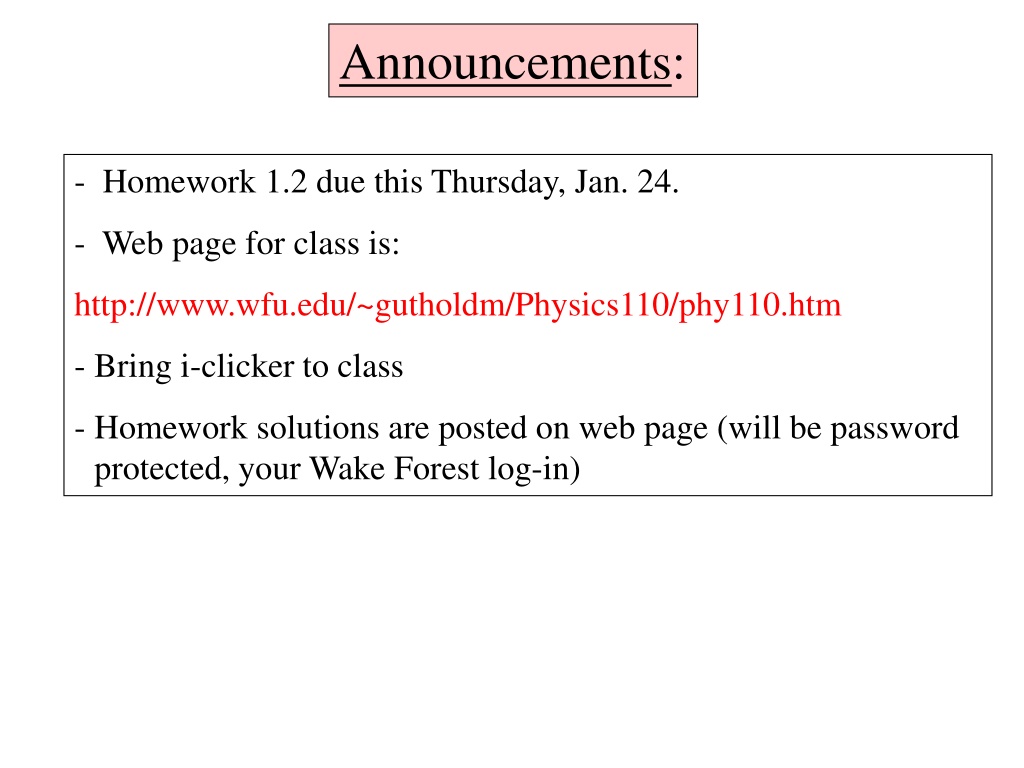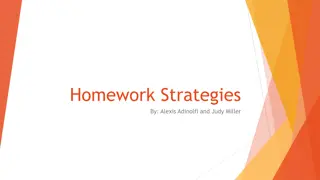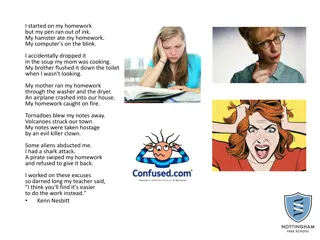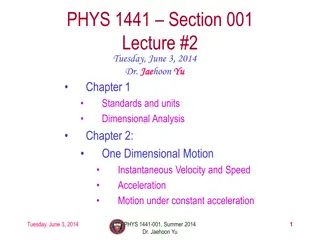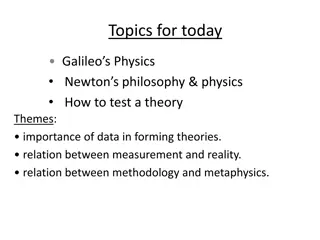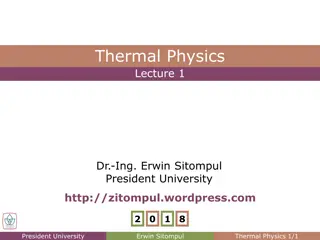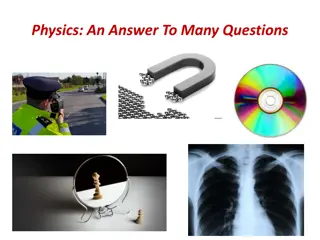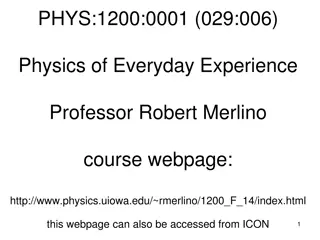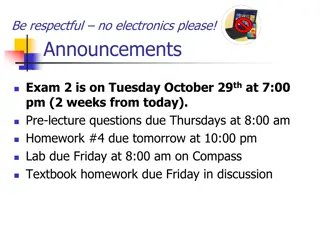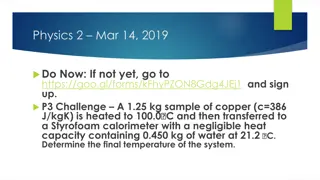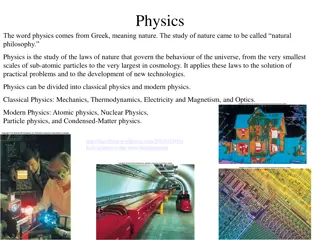Physics 110 Announcements and Homework Details
Stay updated with Physics 110 announcements, homework due dates, web page information, tutor sessions, reading assignments, and concepts covered in class. Make sure to bring your i-clicker and check the provided resources for homework solutions and additional support available. Keep track of important dates and topics to excel in your physics studies.
Download Presentation

Please find below an Image/Link to download the presentation.
The content on the website is provided AS IS for your information and personal use only. It may not be sold, licensed, or shared on other websites without obtaining consent from the author.If you encounter any issues during the download, it is possible that the publisher has removed the file from their server.
You are allowed to download the files provided on this website for personal or commercial use, subject to the condition that they are used lawfully. All files are the property of their respective owners.
The content on the website is provided AS IS for your information and personal use only. It may not be sold, licensed, or shared on other websites without obtaining consent from the author.
E N D
Presentation Transcript
Announcements: - Homework 1.2 due this Thursday, Jan. 24. - Web page for class is: http://www.wfu.edu/~gutholdm/Physics110/phy110.htm - Bring i-clicker to class - Homework solutions are posted on web page (will be password protected, your Wake Forest log-in)
PHY 110 TUTOR SESSIONS (will be combined with PHY 113 and PHY 114 tutorials) Monday Tuesday Wednesday Thursday Friday Phy 113/110 (Olin 103) Lucas Tommervik Daniel Vickers Martin Gamer Daniel Vickers Martin Gamer Phy 114/110 (Olin 101) Dizhou Wu Ray Clark Dizhou Wu Ray Clark Lucas Tommervik The tutor sessions in semesters past were successful and received high marks from many students. All students are encouraged to take advantage of this opportunity. Tutor sessions will last two hours; see specific times below. See table above for location. Monday Thursday, 5:00 pm 7:00 pm, Friday, 4:00 pm 6:00 pm Private tutors are also available: see Kittye McBride in department office (Olin 100)
Chapter 1: The laws of motion, Part I First two chapters: Introduce the language of physics Subsequent chapters: Explore objects and underlying physical concepts - Reading assignment for today: Chapter 1.3 - Reading assignment for next class: Chapter 2.1 - Homework 1.3: (due Thursday, Jan. 31, in class): Exercises: 20, 23, 24, 27, 34, 35, 39 Problem: 8, 9, 10, 13, 14, 15, 16, 22
Chapter 1.3 Newton III, energy,work, ramps Concepts Demos and Objects - Newton s third law: every action has an equal and opposite reaction - Net force - Work and energy - Kinetic energy - Gravitational potential energy - Ramps - Tug of war - Lifting stuff - Carrying stuff - Using a ramp
i-clicker question-1: An apple is sitting on your desk. Which statements are true. A. Only the force of gravity acts on the apple. B. At least one more force acts on the apple. C. Not enough information. D. It is not possible that more than one force acts on an object. E. A & D.
Ball resting on table: Type of Force What kind of forces do we see ? On ball: Weight (gravity): down Support force: up Prevents something from penetrating a surface Points directly away from that surface (perpendicular to surface) The net force on the apple is zero
Physics Concept Net Force The sum of all forces on an object. Determines object s acceleration. Tug-of-war
Newtons Third Law For every force that one object exerts on a second object, there is an equal but oppositely directed force that the second object exerts on the first object. F12 = -F21
i-clicker question-2: If you push on a friend (on ice, no friction), how will the force you exert on your friend compare to the force your friend exerts on you? A. You push harder B. Your friend pushes harder C. The forces are equal in magnitude
Ball resting on table (revisited): Forces Present: What kind of forces can we see? 1. 2. 3. 4. On earth due to gravity from the ball On ball due to gravity from the earth (weight) On ball due to support from table On table due to support from ball Pair Pair Since the ball doesn t accelerate, 2 and 3 must cancel perfectly
Two Crucial Notes: While the forces two objects exert on one another must be equal and opposite, the net force on each object can be anything. Each force within an equal-but-opposite pair is exerted on a different object, so they don t cancel directly.
If the force of the cart on the donkey is the same (but oppositely directed) as the force of the donkey on the cart, why does it move?
Why does the Donkey Move? F=ma so adonkey = F(on donkey)/mdonkey Force of cart on donkey Force of gravity Force of the ground on donkey +Fgravity Net Forceon donkey = Fground on donkey+Fcart on donkey
Why does the Cart AND Donkey Move? F=ma so acart+donkey = F(on cart+donkey)/mcart+donkey Force of the ground on cart Force of the ground on donkey Force of gravity +Fgravity Net Forceon donkey = Fground on donkey+Fground on cart
i-clicker question-3: The diagram shows a top view of three people pulling on a donkey (disk) of mass 100 kg. Ignoring other forces (friction; gravity and support force cancel, etc), what is the acceleration of the donkey? A. 0.5 m/s2 up; B. 1.0 m/s2 up; C. 0 m/s2 up; D. 50.0 m/s2 up; E. 0 m/s2 up; 1.0 m/s2 left 2.0 m/s2 left 1.0 m/s2 left 100 m/s2 left 0 left 100 N 100 N 50 N
Ft = Ff + Fg So Ft= m a = 0 and a = 0! Sum of Floor Forces Force Due to Gravity = m g
Net force on piano Force from ramp Net Force = m a Component into ramp Force due to gravity = weight
Force from ramp Net Force Component into ramp Weight = mg largeF mediumF small F Net downwards force on piano depends on angle
Challenge: Get the piano up to the second floor! Ramp or Straight Lift? RAMP 2000N! Straight Lift
Observations About Ramps Lifting an object straight up is often difficult Pushing the object up a ramp is usually easier The ease depends on the ramp s steepness Shallow ramps require only gentle pushes You seem to get something for nothing How does distance figure in to the picture?
Physical Quantities: Energy and Work Energy A conserved quantity The capacity to do work Work The mechanical means of transferring energy. work = force distance (where force and distance are in the same direction) Unit of energy & work: 1 N m = 1J (Joule) = 0.238 cal
Energy and Work Energy: the capacity to make things happen Work: is the transference of energy Forms of Energy Kinetic Energy Energy of motion Potential Chemical Energy Gravitational Nuclear Energy Thermal Energy
Energy and Work Energy: the capacity to make things happen Work: is the transference of energy Work = Force x Distance W = F d F=mg=2000N W = Fh = mgh Work is the transfer of energy Where did energy of lifters go? into potential energy of piano! h Gravitational potential energy = m g h
Force from ramp Net Force Component into ramp h Weight = mg W= F d W=Fd W=F d =mgh W Work on piano = change in energy of piano = same!
i-clicker question -4 A man loads a refrigerator onto a truck using a ramp. He claims he would be doing less work if the length of the ramp would be longer. Is this true? A. Yes B. No C. Not enough information
Work Lifting a Piano Going straight up: work = force distance Going up ramp: work = force distance The work is the same, either way!
Black board example 1.3.1: RAMP 2000N! Straight Lift 1. Superman is lifting a piano (mass 100 kg) straight up onto a 1 m high platform. How much work is he doing? i-clicker-4 A. 100 J B. 200 J C. 98 J D. 1 J E. 980 J 2. You are pushing the same piano along a 10 m long (frictionless) ramp onto the 1m platform. How much work are you doing? 3. How much force do you apply to the piano? 4. How much energy did the piano gain by being lifted 5. Where did that energy come from?
How much work is done when just holding up an object? = W W F d =
What is the work done when lifting? = W W F d = Strongest man lifting up 140 kg boulder by 1 m.
Black board example 1.3.2 Angus is pulling a 10,000 kg truck with all his might (2000N) on a frictionless surface for 10.0 m. How much work is the man doing? What kind of energy does the truck gain? What is the speed of the truck if he pulls for ten seconds?
